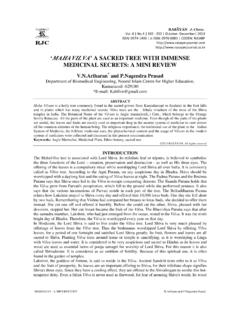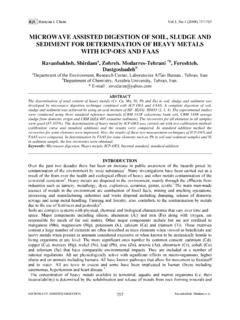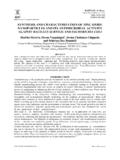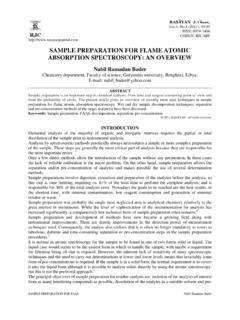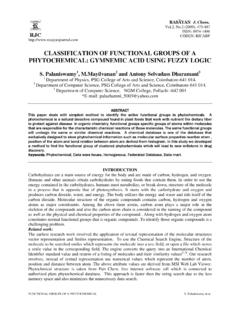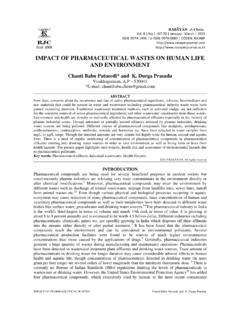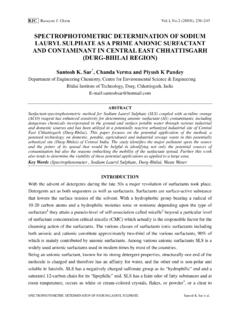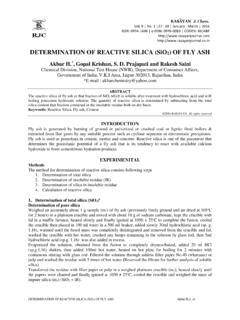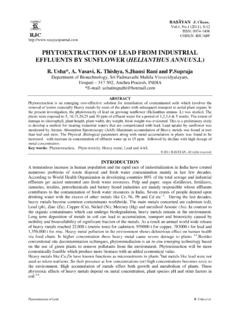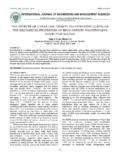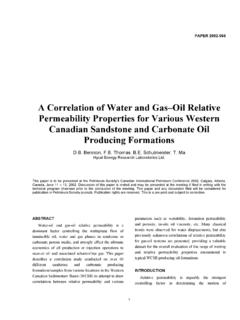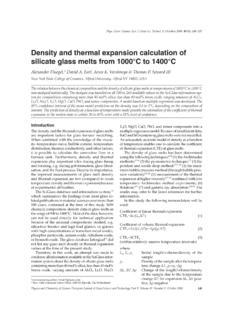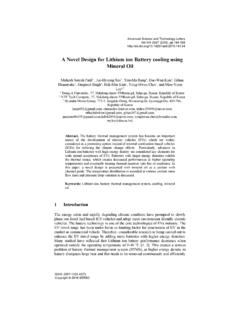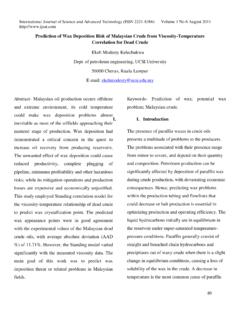Transcription of STUDY OF PHYSICO-CHEMICAL PROPERTIES OF …
1 , (2011), 461-465 ISSN: 0974-1496 CODEN: RJCABP PROPERTIES OF EFFLUENTS FROM SOAP INDUSTRY P. V. Tekade et. al STUDY OF PHYSICO-CHEMICAL PROPERTIES OF EFFLUENTS FROM SOAP INDUSTRY IN WARDHA P. V. Tekade*, N. P. Mohabansi and Patil Department of Chemistry, Jankidevi Bajaj College of science, Jamnalal Bajaj Marg, Civil lines, (India) *E-mail ABSTRACT PHYSICO-CHEMICAL parameters of the effluents from soap industry of Wardha region had been analyzed. In this investigation PHYSICO-CHEMICAL parameters such as colour, odour, temperature, density, surface tension, viscosity, alkalinity, acidity, chloride, hardness, total dissolved solids, total suspended solid, pH, conductance, sulphate, COD, BOD, DO, pathogen had been analyzed of the effluent collected from the soap industry of Wardha region.
2 Sodium and potassium elements were analyzed flame photometrically. Key words: soap industry effluents, PHYSICO-CHEMICAL parameters, COD, BOD, DO. 2011 RAS YAN. All rights reserved. INTRODUCTION This paper discuss the water quality of effluent from the soap industry of Wardha region .The water coming from this source has significant impact on the quality and sustainability of the rivers. Industrial effluents, direct discharges, as well as precipitation may introduce a wide variety of pollutants into the rivers ranging from agrochemicals, heavy metals, microbial as well as persistent organic pollutants. It is noteworthy that this paper discusses the secondary data collected from soap industry and determines the water quality parameters of the collected samples.
3 The discussion is divided into PHYSICO-CHEMICAL , chemical , metals, microbial and organic characteristics of the soap industry effluent. Water of good drinking quality is of basic importance to human physiology and man s continued existence depends very much on its availability1. The provision of portable water to the rural and urban population is necessary to prevent health hazards2. Before water can be described as potable, it has to comply with certain physical, chemical and microbiological standards, which are designed to ensure that the water is palatable and safe for drinking3. Potable water is defined as water that is free from diseases producing microorganisms and chemical substances deleterious to health4. Unfortunately, clean, pure and safe water only exists briefly in nature and is immediately polluted by prevailing environmental factors and human activities.
4 Water from most sources is therefore unfit for immediate consumption without some sort of treatment5. The consequences of waterborne bacteria and virus infection; polio, hepatitis, cholera, typhoid, diarrhea, stomach cramps, etc, have been well established but nitrate contamination is just as deadly. Consequent to the realization of the potential health hazards that may result from contaminated drinking water, contamination of drinking water from any source is therefore of primary importance because of the danger and risk of water borne diseases6. The original source of any drinking water is rich in aquatic microbes, some of which could be dangerous if they enter the human body. Accordingly, the treatment of water for drinking involves stages where microbes are removed or destroyed before the water gets into homes.
5 After purification the water is subjected to tests by bacteriologists to ensure the safety for human consumption. A long series of dilutions is not necessary by some samples because most water supplied are low in bacteria content, while others require long series of In many developing countries, availability of water has become a critical and urgent problem and it is a matter of great concern to families and communities depending on non-public water supply system. Conformation with microbiological standard is of special interest because of the capacity of water to spread diseases within a large population. Although the standards vary from place to place, the objective , (2011), 461-465 PROPERTIES OF EFFLUENTS FROM SOAP INDUSTRY P.
6 V. Tekade et. al 462 anywhere is to reduce the possibility of spreading water borne diseases to the barest minimum in addition to being pleasant to drink, which implies that it must be wholesome and palatable in all respects6. The principal objectives of municipal water are the production and the distribution of safe water that is fit for human consumption1. A good knowledge of the chemical qualities of raw water is necessary so as to guide its suitability for use. Thus, regular PHYSICO-CHEMICAL analysis of water at source must be carried out to determine or check the effectiveness of treatment process. This works is therefore, in an attempt to examine the soap industrial effluent of Wardha, Maharashtra for conformity to microbiological and physicochemical standards.
7 EXPERIMENTAL In this STUDY water samples have been collected in polythene bottles with necessary precaution at points at which effluents discharge into drains for laboratory analysis. Determination of parameters like colour, odour, temperature, density, surface tension, viscosity, alkalinity, acidity, chloride, hardness, total dissolved solids (TDS), total suspended solids (TSS),dissolved oxygen (DO), nitrogen, sodium, potassium and pathogens were carried out in the laboratory. pH and electrical conductance were carried out using pH-meter and conductometer respectively. Sodium, (Na) and Potassium (K) were determined by using flame photometer. Sulphate ion concentration (SO42-) was determined by using U. spectrophotometer. chemical oxygen demand (COD) was determined by the dichromate digestion method while biochemical oxygen demand (BOD) was determined by the dilution method.
8 The chemicals used were used of AR grade. Double distilled water is used for the preparation of solutions and reagents. All equipments were checked and calibrated according to the manufacturer s specifications. The pH meter was calibrated using buffers of pH , and ; Conductivity meter was calibrated by using conductivity water. The spectrophotometers (Systronic 108 and Systronic 166) were checked for malfunctioning by passing standard solutions of all the parameters to be measured. Blank samples (deionized water) were passed between every three measurements of effluent samples so as to check for any eventual contamination or abnormal response of equipment. Reproducibility of results was regularly checked by carrying out periodic analysis of the effluent collected from one sample.
9 RESULTS AND DISCUSSION Temperature, colour and odour In the presence STUDY , temperature ranges from 25-28oC. Colour of the water is a subject of both scientific STUDY and popular misconception. This test is usually applicable to both drinking and potable water. This test is basically carried out by comparison with known standards. Both colour and odour are often cost by organic substances such as algae and humic compounds. The presence of colour in water does not necessarily indicate that water is not potable. Colour causing substances such as tannins may be harmless. The effluent collected was found to be colourless and odourless may be due to absence of organic and human contamination. Density, surface tension and viscosity Higher the density greater is the surface tension.
10 In the collected samples the density was found to be Kg/m3, while the density of pure water at 28-30oC should be Kg/m3 approximately. The surface tension of water sample was found to be X 10-2, N/m. The value of viscosity was found to be This is more than distilled water means the dissolved impurities were present in the studied sample. Electrical Conductance (EC) Conductance measurements are a rapid and practical parameter of the variation of dissolved nutrients and micro-nutrients contents of water samples. More the dissolved solids in water, more is the EC. EC of the water is the sum of ionic conductance of all the ionic constituents. The most expedient to evaluate the salinity of water is to measure its electrical conductance.
